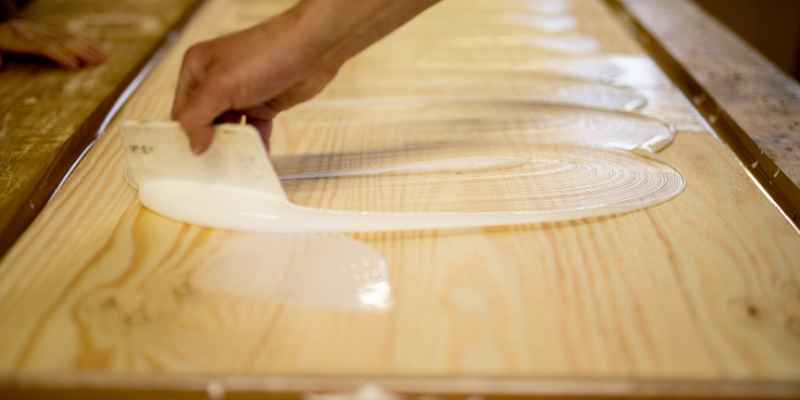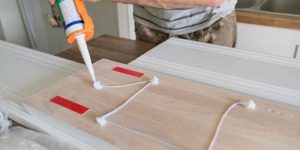The best glue for wood onto Masonite is a high-quality wood adhesive that provides a strong and durable bond. This type of glue is specially formulated to bond wood to Masonite and ensures a secure and long-lasting attachment.
It is important to choose a glue that is suitable for both porous surfaces like wood and non-porous surfaces like Masonite to achieve optimal results. With the right wood adhesive, you can confidently join these two materials together for various woodworking projects.
Whether you are working on furniture, cabinets, or crafts, using the best glue for wood onto Masonite will ensure a reliable and sturdy bond.
Introduction To Wood And Masonite Adhesion
When it comes to bonding wood onto masonite, choosing the right adhesive is crucial for a strong and durable connection. Understanding the characteristics of wood and masonite is essential in selecting the best glue for the job.
The Importance Of Choosing The Right Glue
Choosing the right glue for wood onto masonite is crucial to ensure a strong and long-lasting bond. The wrong adhesive can result in weak adhesion, leading to potential failure of the bond over time. It’s essential to consider the specific properties of both wood and masonite to make an informed decision about the most suitable glue for the application.
Characteristics Of Wood And Masonite
Wood is a porous and fibrous material, while masonite, also known as hardboard, is a dense and smooth composite wood product. The differing characteristics of these materials can present challenges when it comes to adhesion. Wood requires an adhesive that can penetrate its porous surface, while masonite needs a glue that can create a strong bond with its smooth texture.
Types Of Glue Suitable For Wood To Masonite
When it comes to bonding wood to Masonite, choosing the right type of glue is essential for a strong and durable bond. There are several types of glue suitable for this purpose, each with its own unique properties and applications.
Pva Glues
PVA (polyvinyl acetate) glues are versatile and commonly used for bonding wood to Masonite. These glues are easy to use and clean up, making them a popular choice for woodworking projects. PVA glues form a strong bond and are suitable for indoor applications.
Epoxy Resins
Epoxy resins are known for their exceptional strength and durability. These glues are ideal for bonding wood to Masonite in applications where a high level of strength and resistance to moisture and temperature is required. Epoxy resins create a strong, waterproof bond, making them suitable for both indoor and outdoor projects.
Polyurethane Adhesives
Polyurethane adhesives offer excellent bond strength and are suitable for bonding wood to Masonite in various conditions, including high humidity and temperature changes. These adhesives also provide some flexibility, making them suitable for applications where some movement or stress may occur.
Top Recommended Glues For Durability
When it comes to bonding wood onto masonite, using the right glue is essential for ensuring a strong and durable bond. The top recommended glues for durability are heavy-duty epoxy, advanced PVA glue, and polyurethane-based solution. Each of these glues offers unique advantages for securing wood onto masonite, providing long-lasting and reliable adhesion.
Brand A: Heavy-duty Epoxy
Heavy-duty epoxy is a popular choice for bonding wood onto masonite due to its exceptional strength and durability. This type of glue forms a strong, waterproof bond that can withstand heavy loads and environmental stresses. It is ideal for applications where a highly resilient bond is required, such as in woodworking, construction, and furniture making.
Brand B: Advanced Pva Glue
Advanced PVA glue is known for its versatility and ease of use when bonding wood onto masonite. This type of glue offers a strong initial tack and dries to a clear finish, making it suitable for a wide range of woodworking projects. Advanced PVA glue is resistant to heat, humidity, and solvents, ensuring a reliable and long-lasting bond between wood and masonite.
Brand C: Polyurethane-based Solution
Polyurethane-based solution provides exceptional bonding strength and versatility for wood-to-masonite applications. This type of glue is highly resistant to moisture, making it suitable for both indoor and outdoor projects. Additionally, polyurethane-based glue expands as it cures, filling gaps and creating a robust bond that can withstand varying environmental conditions.
Application Techniques For Strong Bonds
Surface Preparation
Begin by sanding both the wood and Masonite surfaces.
Remove any dust or debris for a clean bond.
Glue Spreading Methods
Apply wood glue evenly on both surfaces.
Spread using a brush or roller for uniform coverage.
Clamping And Drying Times
Clamp the surfaces together firmly for a strong bond.
Allow 24 hours for the glue to fully dry.
Factors Affecting Adhesive Performance
For optimal performance when bonding wood to Masonite, consider factors affecting adhesive strength like surface preparation, adhesive type compatibility, and application method. Choose a high-quality wood glue or polyvinyl acetate (PVA) adhesive for a strong and durable bond.
When it comes to bonding wood onto masonite, choosing the right adhesive can make all the difference in the durability and longevity of the bond. However, there are several factors that can affect the performance of the adhesive, including environmental conditions, material compatibility, and load-bearing requirements. Here’s what you need to know about each factor:
Environmental Conditions
The environment in which the adhesive will be used can have a significant impact on its performance. Factors such as temperature, humidity, and exposure to sunlight can all affect the strength of the bond. For example, if the adhesive will be used in a high-temperature environment, it’s important to choose an adhesive that can withstand the heat. Similarly, if the adhesive will be exposed to sunlight, it’s important to choose an adhesive that won’t break down or degrade under UV light.
Material Compatibility
Another important factor to consider when choosing an adhesive is material compatibility. Not all adhesives are suitable for bonding all types of materials. For example, some adhesives may not adhere well to certain types of wood or masonite. It’s important to choose an adhesive that is specifically designed for bonding wood onto masonite and that has been tested for compatibility with the specific materials you will be using.
Load-bearing Requirements
Finally, load-bearing requirements are an important consideration when choosing an adhesive. If the bond will be subjected to heavy loads or stress, it’s important to choose an adhesive that can handle the weight and pressure. Additionally, if the bond will be subjected to vibrations or movement, it’s important to choose an adhesive that can flex and move with the materials without compromising the strength of the bond.
In conclusion, when it comes to bonding wood onto masonite, choosing the right adhesive is crucial for achieving a strong, durable bond. By considering factors such as environmental conditions, material compatibility, and load-bearing requirements, you can choose an adhesive that will perform well and stand the test of time.
Safety Precautions And Cleanup

When working with glue for wood onto Masonite, it is crucial to prioritize safety precautions and proper cleanup to avoid any accidents or mishaps. By following the recommended guidelines, you can ensure a safe and efficient working environment.
Personal Protective Equipment
- Wear safety goggles to protect your eyes from splashes.
- Use gloves to shield your hands from direct contact with the glue.
- Put on a mask to prevent inhalation of harmful fumes.
Handling Spills And Residue
- Immediately clean up any spills with a damp cloth.
- Scrape off excess glue with a putty knife.
- Use a solvent recommended for the specific type of glue.
Proper Ventilation
Ensure the workspace has adequate ventilation to disperse fumes and maintain air quality. Open windows or use a ventilation fan to improve air circulation.
Case Studies: Real-world Applications
When it comes to bonding wood onto Masonite, finding the right glue is crucial for a strong and durable hold. There are various types of glue available in the market, but not all of them are suitable for this specific application. In this blog post, we will discuss the best glue for wood onto Masonite and dive into case studies of real-world applications in furniture making, artistic installations, and architectural models.
Furniture Making
Furniture making requires a strong bond between wood and Masonite to ensure the longevity of the piece. One of the best glues for this application is polyurethane glue. This type of glue creates a strong bond and is resistant to moisture, making it ideal for furniture pieces that may be exposed to different environments.
Case Study:
| Furniture Piece | Glue Used | Result |
|---|---|---|
| Tabletop | Polyurethane glue | The tabletop has remained strong and durable, even after exposure to different temperatures and humidity levels. |
Artistic Installations
Artistic installations often require bonding wood onto Masonite for structural support. In this case, epoxy glue is an excellent option. Epoxy glue creates a strong bond that can withstand pressure and stress, making it ideal for installations that may be subjected to movement or weight.
Case Study:
- Art Installation: Wooden sculpture on Masonite base
- Glue Used: Epoxy glue
- Result: The sculpture has remained intact and stable despite being subjected to movement and weight.
Architectural Models
Architectural models require precision and durability, and the bond between wood and Masonite must be strong. For this application, cyanoacrylate glue, commonly known as super glue, is an excellent option. This type of glue dries quickly and creates a strong bond that can withstand pressure and stress.
Case Study:
- Architectural Model: Residential building model
- Glue Used: Cyanoacrylate glue (super glue)
- Result: The bond between the wood and Masonite has remained strong, even after being transported multiple times.
In conclusion, choosing the right glue is essential for bonding wood onto Masonite. Polyurethane glue is ideal for furniture making, epoxy glue is suitable for artistic installations, and cyanoacrylate glue is perfect for architectural models. By selecting the appropriate glue for each application, you can ensure a strong and durable bond that will last for years to come.
Conclusion: Making The Right Choice
Choosing the right glue for wood onto masonite can be tricky. It’s important to consider factors such as strength, drying time, and ease of use. Researching different options and testing them out can help ensure you make the best choice for your project.
Recap Of Top Glue Picks
After considering the different types of glue for wood onto masonite, we have come up with the top picks. The first one is Titebond III Ultimate Wood Glue. It is waterproof and can bond different types of wood to masonite. The second one is Gorilla Wood Glue. It has a strong initial tack and can bond wood to masonite in just 20-30 minutes. Lastly, we have the Elmer’s Carpenter’s Wood Glue Max. It has a longer working time and can also be sanded and painted over once dry.
Final Thoughts On Wood To Masonite Adhesion
When it comes to choosing the best glue for wood onto masonite, it is important to consider the specific project requirements. A waterproof glue may be necessary for projects that will be exposed to moisture, while a quick-drying glue may be more suitable for time-sensitive projects. Additionally, it is important to follow the manufacturer’s instructions and allow sufficient drying time before handling or using the bonded materials.
Overall, choosing the right glue for wood onto masonite can make a significant impact on the quality and durability of the finished product. By considering the specific project requirements and selecting a high-quality glue, you can ensure a strong and long-lasting bond between the wood and masonite.

Frequently Asked Questions
What Is The Best Glue For Wood Onto Masonite?
The best glue for wood onto Masonite is polyvinyl acetate (PVA) glue. It provides a strong bond, dries clear, and is easy to use. Make sure to apply an even layer and clamp the surfaces together for optimal adhesion.
Can You Use Wood Glue On Masonite?
Yes, you can use wood glue on Masonite. Polyvinyl acetate (PVA) glue is a suitable option for bonding wood to Masonite surfaces. Apply a generous amount of glue evenly on both surfaces, press them together, and let the glue dry completely for a secure bond.
How Long Does Wood Glue Take To Dry On Masonite?
Wood glue typically takes around 30 minutes to set on Masonite surfaces. However, it is recommended to allow the glue to dry for at least 24 hours before subjecting the bonded materials to any stress or load to ensure a strong and durable bond.
Is It Necessary To Clamp Wood And Masonite When Using Glue?
Clamping wood and Masonite together when using glue is essential to ensure a strong and secure bond. The pressure applied by clamps helps to squeeze out excess glue, eliminates gaps between the surfaces, and promotes optimal adhesion, resulting in a long-lasting bond.
Conclusion
Choosing the best glue for wood onto Masonite is crucial for achieving strong and durable bonds. From our exploration of various options, it is evident that wood glue, epoxy, and construction adhesive are popular choices. However, it ultimately depends on the specific project requirements and personal preferences.
Remember to consider factors such as drying time, strength, and ease of application when making your selection. By following these guidelines, you can ensure a successful and long-lasting wood-to-Masonite bond.


